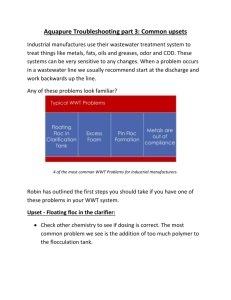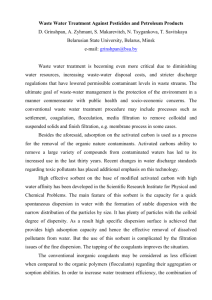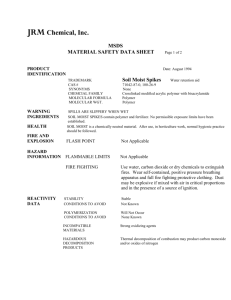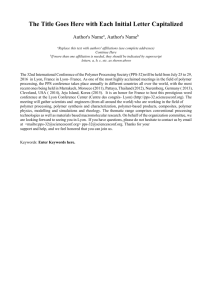SC-13 Polymer/ Coagulants/ Flocculants for
advertisement
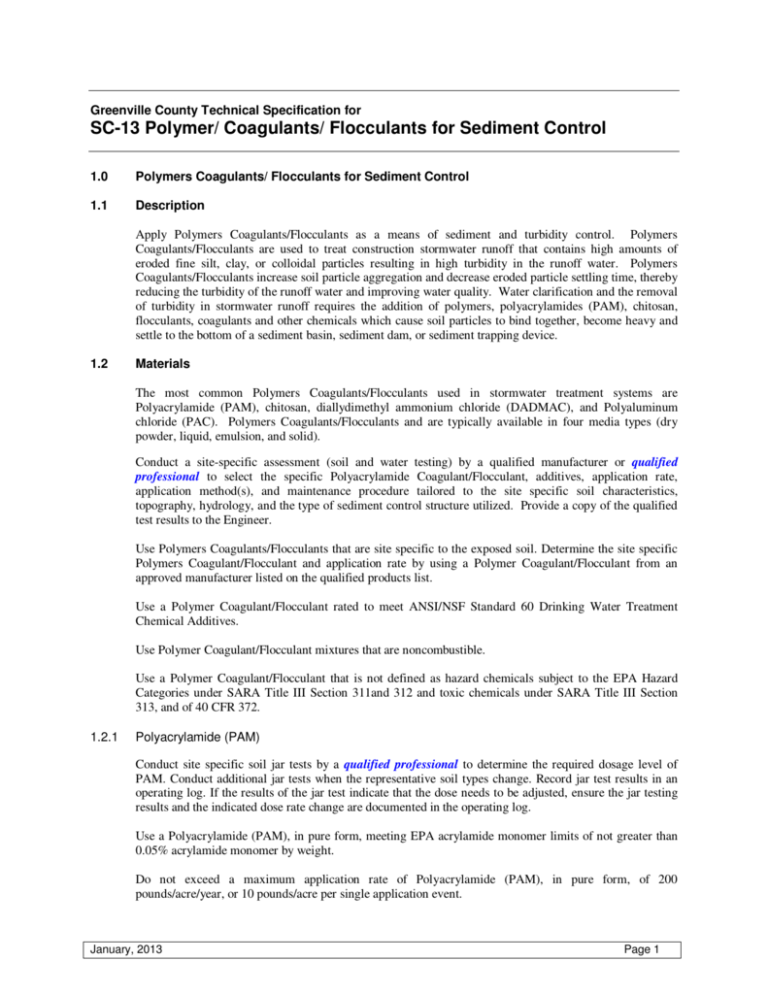
Greenville County Technical Specification for SC-13 Polymer/ Coagulants/ Flocculants for Sediment Control 1.0 Polymers Coagulants/ Flocculants for Sediment Control 1.1 Description Apply Polymers Coagulants/Flocculants as a means of sediment and turbidity control. Polymers Coagulants/Flocculants are used to treat construction stormwater runoff that contains high amounts of eroded fine silt, clay, or colloidal particles resulting in high turbidity in the runoff water. Polymers Coagulants/Flocculants increase soil particle aggregation and decrease eroded particle settling time, thereby reducing the turbidity of the runoff water and improving water quality. Water clarification and the removal of turbidity in stormwater runoff requires the addition of polymers, polyacrylamides (PAM), chitosan, flocculants, coagulants and other chemicals which cause soil particles to bind together, become heavy and settle to the bottom of a sediment basin, sediment dam, or sediment trapping device. 1.2 Materials The most common Polymers Coagulants/Flocculants used in stormwater treatment systems are Polyacrylamide (PAM), chitosan, diallydimethyl ammonium chloride (DADMAC), and Polyaluminum chloride (PAC). Polymers Coagulants/Flocculants and are typically available in four media types (dry powder, liquid, emulsion, and solid). Conduct a site-specific assessment (soil and water testing) by a qualified manufacturer or qualified professional to select the specific Polyacrylamide Coagulant/Flocculant, additives, application rate, application method(s), and maintenance procedure tailored to the site specific soil characteristics, topography, hydrology, and the type of sediment control structure utilized. Provide a copy of the qualified test results to the Engineer. Use Polymers Coagulants/Flocculants that are site specific to the exposed soil. Determine the site specific Polymers Coagulant/Flocculant and application rate by using a Polymer Coagulant/Flocculant from an approved manufacturer listed on the qualified products list. Use a Polymer Coagulant/Flocculant rated to meet ANSI/NSF Standard 60 Drinking Water Treatment Chemical Additives. Use Polymer Coagulant/Flocculant mixtures that are noncombustible. Use a Polymer Coagulant/Flocculant that is not defined as hazard chemicals subject to the EPA Hazard Categories under SARA Title III Section 311and 312 and toxic chemicals under SARA Title III Section 313, and of 40 CFR 372. 1.2.1 Polyacrylamide (PAM) Conduct site specific soil jar tests by a qualified professional to determine the required dosage level of PAM. Conduct additional jar tests when the representative soil types change. Record jar test results in an operating log. If the results of the jar test indicate that the dose needs to be adjusted, ensure the jar testing results and the indicated dose rate change are documented in the operating log. Use a Polyacrylamide (PAM), in pure form, meeting EPA acrylamide monomer limits of not greater than 0.05% acrylamide monomer by weight. Do not exceed a maximum application rate of Polyacrylamide (PAM), in pure form, of 200 pounds/acre/year, or 10 pounds/acre per single application event. January, 2013 Page 1 Use a Polyacrylamide (PAM) with a charge density of 10% to 55%, by weight and a molecular weight of 6 to 24 Mg/mole. Use water soluble, linear, or non-cross linked Polyacrylamides (PAM). Do not use cross-linked, or super water-absorbent Polyacrylamides. 1.2.2 Chitosan Acetate Conduct site specific soil jar tests by a qualified professional to determine the required dosage level of chitosan acetate solution. Conduct additional jar tests when the representative soil types change. Record jar test results in an operating log. If the results of the jar test indicate that the dose needs to be adjusted, ensure the jar testing results and the indicated dose rate change are documented in the operating log. The target chitosan acetate dose rate for water entering sediment trapping devices is 1 mg/L (chitosan acetate by weight). Implement source control procedures to the maximum extent practicable to minimize the need for the use of additional chitosan acetate for the treatment of stormwater. Use additional amounts (chitosan acetate by weight) greater than 1 mg/L to pretreat stormwater runoff water that exceeds 600 NTU. Ensure pretreatment occurs in a tank, system, basin, or sediment trapping device dedicated to pretreatment. Ensure that free chitosan does not enter the receiving water body. On a case by case evaluation, Greenville County may require monitoring of the effluent for residual chitosan or aquatic toxicity. When monitoring, ensure effluent discharges are below 0.2 ppm residual chitosan at all times. In the event that the chitosan residual in the discharge is greater than 0.2 ppm, or the discharge exhibits aquatic toxicity, a contingency plan must be included in every SWPPP that immediately corrects the situation 1.2.3 Aquatic Toxicity 1.2.3.1 Acute Toxicity For all applications, ensure that the site specific Polymer Coagulant/Flocculant application rate is non-toxic based on the results of Acute Toxicity testing. Submit an acute static toxicity report for each specific Polymer Coagulant/Flocculant listing the LC50 values for each specific Polymer Coagulant/Flocculant. Determine the acute toxicity of the Polymer Coagulant/Flocculant according to EPA “Methods for Measuring Acute Toxicity of Effluents and Receiving Waters to Freshwater and Marine Organisms” (EPA 821-R-02-012. Use 96 hour static survival tests conducted on Rainbow Trout (Oncorhynchus mykiss) or Fathead Minnow (Pimephales promelas), and 48 hour static survival tests conducted on Daphnia magna or Ceriodaphnia dubia. Use a SCDHEC certified laboratory for all toxicity analyses. Ensure laboratory analyses include at minimum, a series of five effluent concentrations to show adequate information on the dose-response relationship. Test concentrations consist of a control sample and at least five effluent concentration samples in the following concentrations: 6.25%, 12.5%, 25%, 50% and 100%. The LC50 value represents 50% lethal concentration, or the concentration at which 50% of test organisms are killed from free Polymer Coagulant/Flocculant (not interacting with turbid runoff). In a stormwater treatment scenario, the LC50 data is relevant to a worst-case scenario, in which the free Polymer Coagulant/Flocculant is released directly to the downstream receiving waters. January, 2013 Page 2 1.2.3.2 Chronic Toxicity On a case by case evaluation, Greenville County may require that the site specific Polymer Coagulant/Flocculant application rate is non-toxic based on the results of Chronic Toxicity Testing. Submit a 7-day chronic static toxicity report for each specific Polymer Coagulant/Flocculant listing the IC25, LC25, and the No Observed Effect Concentration (NOEC) values for each specific Polymer Coagulant/Flocculant. Determine the chronic toxicity of the Polymer Coagulant/Flocculant according to EPA “Short Term Methods For Estimating The Chronic Toxicity of Effluents and Receiving Water to Freshwater Organisms” (EPA/821-R-02-013). Use a SCDHEC certified laboratory for all toxicity analyses. Use Daphnid (Ceriodaphnia dubia, or Daphnia magna) for Survival (LC25 and NOEC) and Reproduction (IC25 and NOEC) Tests. Use Rainbow Trout (Oncorhynchus mykiss) or Fathead Minnow (Pimephales promelas) for Chronic Definitive Larval Survival (LC25 and NOEC) and Growth (IC25 and NOEC) Tests. Use a SCDHEC certified laboratory for all toxicity analyses. Ensure laboratory analyses include at minimum, a series of five effluent concentrations to show adequate information on the dose-response relationship. Test concentrations consist of a control sample and at least five effluent concentration samples in the following concentrations: 6.25%, 12.5%, 25%, 50% and 100%. The IC25 value represents the Inhibition Concentration of the sample at which there is a 25% reduction in growth or reproduction when compared to the laboratory control. The LC25value represents the lethal concentration of Polymer Coagulant/Flocculant tested that exhibits toxicity by mortality in 25% of the organisms tested. The NOEC value represents the No Observed Effect Concentration, or the highest concentration tested that did not exhibit chronic toxicity. 1.2.4 Quality Assurance Provide Polymers Coagulants/Flocculants from a manufacturer listed on the most recent approved products list for Polymers Coagulants/Flocculants for Sediment Control. At the time of delivery, provide the Engineer with the Polymer Coagulant/Flocculant packing list containing complete identification including, but not limited to, the following: • • • • • 1.3 Manufacturer’s name and location. Manufacturer’s telephone number and fax number. Manufacturer’s e-mail address and web address. Polymer Coagulant/Flocculant name, model, and/or serial number. Certification that the sediment tube meets the physical and performance criteria of this specification. Construction Requirements Polymers Coagulant/Flocculants are available in four media types (dry powder, liquid, emulsion, and solid). The powder, liquid, and emulsion media are applied directly to short, steep slopes, exposed soil surfaces, ditch checks, sediment tubes, and stormwater conveyance structures. Solid Polymer Coagulant/Flocculant is placed directly into the stormwater runoff conveyance to enhance eroded particle settlement in a downstream sediment control structure. January, 2013 Page 3 Ensure a sediment basin, sediment trap, or sediment trapping structure or device is installed downstream of where the Polymer Coagulant/Flocculant is applied to reduce turbidity. 1.3.1 Passive Treatment Systems The following Passive Treatment Systems are acceptable for use where turbidity removal is required. • Dry Powder Polymer Coagulant/Flocculant treated sediment tubes, ditch checks, or weirs installed upgrade from a sediment basin, sediment dam, or other sediment trapping structure or device. • Addition of Dry Powder Polymer Coagulant/Flocculant directly on bare soil or directly into a stormwater conveyance ditch, upgrade from a sediment basin, sediment dam, or other sediment trapping structure or device. • Erosion control blankets, turf reinforcement mats, and sediment tubes pre-inoculated with Polymer Coagulant/Flocculant, installed upgrade from a sediment basin, sediment dam, or other sediment trapping structure or device. • Mechanical, pumped, or gravity metered application of Liquid and Emulsion Polymer Coagulant/Flocculant directly into the stormwater runoff conveyance ditch, pipe or culvert upgrade from a sediment basin, sediment dam, or other sediment trapping structure or device. • Solid Polymer Coagulant/Flocculant blocks, logs and flats installed directly in a stormwater conveyance ditch, pipe or culvert upgrade from a sediment basin, sediment dam, or other sediment trapping structure or device. Ensure that the resulting Polymer Coagulant/Flocculant application rate of the Passive Treatment System does not exceed the Acute Toxicity and if required the Chronic Toxicity levels of the specific Polymer Coagulant/Flocculant. 1.3.2 Active Treatment Systems An active Polymer Coagulant/Flocculant treatment system consists of the stormwater collection system, untreated stormwater storage basins, pumps, chemical feed system, treatment cells, and interconnecting piping. Stormwater runoff is collected on the site and is diverted by gravity or pumping to an untreated stormwater storage basin or other untreated stormwater holding area. The stormwater is stored until treatment occurs. Treatment typically includes pumping water from the untreated stormwater storage basin to the active system where Polymer Coagulant/Flocculant is added. Ensure the holding basin is large enough to provide adequate storage for the specific design storm event required for turbidity reduction. Ensure that the resulting Polymer Coagulant/Flocculant treated stormwater effluent from the Active Treatment System does not exceed the Acute Toxicity and if required the Chronic Toxicity levels of the specific Polymer Coagulant/Flocculant. 1.3.3 Site Specific Polymer Coagulant/Flocculant Soil Testing The application of Polymer Coagulant/Flocculant is site-specific and a specific Polymer Coagulant/Flocculant is required for specific soil types on the construction site to ensure the best performance possible. Ensure a Polymer Coagulant/Flocculant soil test is conducted by a qualified professional for each major discharge point from the active construction site. January, 2013 Page 4 Follow the specific manufacturer’s soil testing requirements. Typical requirements include: • 200g of soil, in a plastic bag or container 1.3.4 • • If there are different types of soil on the site (cut slopes, or fill material), provide samples for each. Mix samples together to form a single composite soil sample when runoff from different representative soil types flows into the same stormwater conveyance ditch or sediment trapping structure. • • • Provide site specific information including project name and station number where the samples are taken. Type of Polymer Coagulant/Flocculant application (dry powder, liquid, emulsion, and solid). Provide distances or lengths of water flow conveyances (pipes, ditches, ect.) as well as the volume of flow expected through these conveyances. Installation Mix and apply Polymer Coagulant/Flocculant in accordance with all Occupational Safety and Health Administration (OSHA) Material Safety Data Sheet (MSDS) requirements and the manufacturer’s recommendations for the specified use conforming to all federal, state and local laws, rules and regulations. The contractor or qualified professional applicator is responsible for obtaining all required permits. A manufacturer’s representative is required to provide application instructions to the contractor or qualified professional applicator and verify the installation according to the manufacturer’s application instructions. Do not over apply Polymer Coagulant/Flocculant. Excessive Polymer Coagulant/Flocculant application can increase suspended solids in water. Application rates of Polymer Coagulant/Flocculant above the results of the site specific soil tests or manufacturer’s recommendation do not provide additional effectiveness. Ensure Polymer Coagulant/Flocculant is not applied directly to natural water bodies. Use a 30-foot minimum setback when applying near wetlands or surface waters. Always apply Coagulant/Flocculant upstream of a sediment basin, sediment dam, ditch checks, sediment tube, De-Watering bag, or other sediment trapping structure or device. Do not apply Polymer Coagulant/Flocculant into an outfall BMP where water discharges directly from the site. Do not apply Polymer Coagulant/Flocculant directly to: • • • Slopes that flow directly into a wetland or state waters Outfalls from sediment basins, sediment traps, or other stormwater management ponds Wetlands or state waters 1.3.4.1 Dry Powder Polymer Coagulant/Flocculant Apply dry powder Polymer Coagulant/Flocculant by hand spreader, mechanical disc, or hand sowing. Ensure application procedures provide uniform coverage to the target area and avoid application or drift to non-target areas. Apply dry powder Polymer Coagulant/Flocculant directly to short, steep slopes, exposed soil surfaces, sediment tubes, ditch checks, runoff conveyance channels, or as a tackifier with temporary seeding to prevent detachment of soil particles during the establishment of vegetation. Application of dry powder Polymer Coagulant/Flocculant to a stormwater conveyance ditch requires sediment tubes, ditch checks, or weirs to effectively mix the powder Polymer Coagulant/Flocculant with the turbid stormwater runoff. Mixing of turbid water and dry powder Polymer Coagulant/Flocculant is essential for the Polymer Coagulant/Flocculant to be functional. January, 2013 Page 5 Dry powder Polymer Coagulant/Flocculant may be mixed with dry silica sand to aid in spreading. Ratios of sand to powder vary in accordance with the type of spreading device used. Apply dry powder Polymer Coagulant/Flocculant to dry soil. 1.3.4.1.1 Typical Coverage Strictly follow the manufacturer’s application recommendations. General coverage rates are: 1.3.4.1.2 • 10 – 20 pounds powder / Acre – gentle to moderate slopes (flat to 4:1) Dry Spread Application • 20 – 50 pounds powder / Acre – steep slopes (3:1 to 1:1) Dry Spread Application Precautions / Limitations • Prevent inhalation of the powder, use an adequate dust mask. • Clean up spills quickly. Do not use water unless necessary, extremely slippery conditions will result. In the event of skin contact, wash power from skin as soon as possible using soap and water. Polymer Coagulant/Flocculant Powder will remain viable on the soil surface for 60-90 days. Longer viability will occur when applied powder is covered with straw or wood fiber mulch. • • • Polymer Coagulant/Flocculant Powders are specifically tailored to specific soil types. Soil types in varying locations on the construction project require separate testing. • If proper performance of Polymer Coagulant/Flocculant is not satisfactory, contact the manufacturer. 1.3.4.2 Liquid Polymer Coagulant/Flocculant Polymer Coagulant/Flocculant Powder may be mixed with water to create a liquid Polymer Coagulant/Flocculant that may be applied with hydroseeders, water trucks, other spraying devices, or other application methods. Ensure that all spraying devices have a mechanical agitator or mixing apparatus or hydraulic recirculation. Do not mix powder in a spraying device that does not contain a mixing apparatus. 1.3.4.2.1 Mixing Strictly follow the manufacturers mixing recommendations. Sprinkle powder into the water with the mixing apparatus operating. Ensure thorough mixing after the powder is sprinkled into the water. Slowly add the powder to the water as adding the powder too fast results in clumping and poor performance. 1.3.4.2.2 Typical Coverage Strictly follow the manufacturer’s application recommendations. A general coverage rate is: 1.3.4.2.3 • 3.5 – 5 pounds dry powder / 1000 gallons water equals 1/3 Acre coverage for Hydroseed Applications. • Do not exceed 8 lbs of dry powder per 1500 gallons as viscosity of the water may damage spraying equipment. Precautions / Limitations • January, 2013 Prevent inhalation of the powder, use an adequate dust mask. Page 6 • • Clean up spills quickly. Do not use water unless necessary, extremely slippery conditions will result. In the event of skin contact, wash power from skin as soon as possible using soap and water. • Do not add water to the Polymer Coagulant/Flocculant Powder, add the powder (sprinkle) to the water slowly. • Polymer Coagulant/Flocculant are specifically tailored to specific soil types. Soil types in varying locations on the construction project require separate testing. If proper performance of Polymer Coagulant/Flocculant is not satisfactory, contact the manufacturer. • 1.3.4.3 Emulsion Polymer Coagulant/Flocculant Do not add water to emulsion Polymer Coagulant/Flocculant. Add Polymer Coagulant/Flocculant emulsion slowly to water at the recommended concentration determined from the site specific soil test. Mix emulsion batches strictly following the manufacturer’s recommendations for the proper product and application rate meeting the specific site requirements. Prepare emulsion Polymer Coagulant/Flocculant mixtures immediately prior to application as effectiveness decreases if too much time passes between mixing and application. Apply Polymer Coagulant/Flocculant emulsion to dry soil. 1.3.4.3.1 Mixing Shake or mix the Polymer Coagulant/Flocculant emulsion container before opening to eliminate separation. Apply emulsion with hydroseeders, water trucks or other spraying devices, or other application methods. Ensure spraying devices have a mechanical agitator, mixing apparatus, or hydraulic recirculation. 1.3.4.3.2 Typical Coverage Strictly follow the manufacturer’s application recommendations. General coverage rates are: • 1.5– 2.0 gallons / 3000 gallons water / Acre – gentle to moderate slopes (flat to 4:1) • 2.0- 2.5 gallons / 3000 gallons water / Acre – steep slopes (3:1 to 1:1) Do not exceed 2.5 gallons of emulsion / 3000 gallons as viscosity of the water may reduce spraying efficiency or damage spraying equipment. 1.3.4.3.3 Precautions / Limitations • Clean up spills quickly using absorbent material such as sand or wood fiber. Do not use water only unless necessary, extremely slippery conditions will result. • Do not add water to Emulsion, add the emulsion to the water slowly while mixing or to the tank filling water stream. In event of skin contact, wash emulsion from skin as soon as possible using soap and water. • • Emulsion remains viable on the soil surface for 60-90 days. Longer viability will occur when applied emulsion is covered with straw or wood fiber mulch. Use Emulsions specifically tailored to specific soil types. Soil types in varying locations on the construction project require separate testing. If proper performance of the Emulsion is not satisfactory, contact the manufacturer. January, 2013 Page 7 • • 1.3.4.4 Solid Form Polymer Coagulant/Flocculant Mixing of turbid water and Solid Form Polymer Coagulant/Flocculant is essential for the Solid Polymer Coagulant/Flocculant to be functional. Select the proper number, size and shape of Solid Polymer Coagulant/Flocculant per the manufacturer’s recommendation to deliver the appropriate dosage within a particular stormwater conveyance. Solid Polymer Coagulant/Flocculant placement is typically determined from design stormwater runoff rates in gallons per minute (GPM) flow rate. The actual GPM or dosage will vary based on site criteria and site specific soil testing. Place Solid Polymer Coagulant/Flocculant directly into the stormwater runoff to enhance eroded particle settlement in a downstream sediment control structure. Place the Solid Polymer Coagulant/Flocculant at the upper end of the stormwater conveyance system or as close as possible to active land-disturbing activities. Place the Solid Polymer Coagulant/Flocculant an appropriate distance upstream of the downstream sediment control structure to ensure adequate turbulence and mixing energy for flocculation to take place in the downstream sediment control structure. Install stakes, nylon mesh bags, wire cages, and other equipment used to maintain and protect the Solid Polymer Coagulant/Flocculant in the center of the stormwater runoff conveyance in accordance with the manufacturer’s directions. Move Solid Polymer Coagulant/Flocculant to different locations as site conditions change. Install sediment tubes, ditch checks, weirs, or other mixing structures in areas with: • • • • 1.3.4.4.1 • • • • • • 1.3.5 Short stormwater conveyance distance, High silt and clay concentrations, Heavy particle concentrations, or Steep slopes. Precautions / Limitations Solid Polymer Coagulant/Flocculant is extremely slippery when wet. Clean up spills quickly, do not use water unless necessary, extremely slippery conditions will result. Use soap and water to wash hands after handling Polymer Coagulant/Flocculant. Plastic or rubber gloves are recommended during application. Solid Polymer Coagulant/Flocculant remains viable for up to 6 months. Solid Polymer Coagulant/Flocculant is specifically tailored to specific soil types. Soil types in varying geographical areas require separate testing. If proper performance of Solid Polymer Coagulant/Flocculant is not satisfactory, contact the manufacturer. Inspection and Maintenance Inspect Polymer Coagulant/Flocculant application areas every 7 days and after each rainfall event. Degradation of Polymer Coagulant/Flocculant is expected to occur as a result of high rainfall, mechanical degradation, chemical, and biological hydrolysis, sunlight, salt, and temperature effects. Reapply Polymer Coagulant/Flocculant in accordance with the manufacturer’s instructions. Reapplication is not required unless Polymer Coagulant/Flocculant treated areas are disturbed or turbidity or water quality show the need for an additional application. Reapply undisturbed Polymer Coagulant/Flocculant treated areas as needed. Further Polymer Coagulant/Flocculant applications may be required for steep slopes, highly silty and clayey soils, long grades, and high traffic or precipitation areas. January, 2013 Page 8 Maintain all equipment to provide the application rates recommended by the manufacturer. In an approved area, rinse all equipment used to mix and apply Polymer Coagulant/Flocculant thoroughly with water to avoid formation of residues. Reuse or dispose recovered flocculated sediments containing Polymer Coagulant/Flocculant in accordance with local, state, and Federal regulations. 1.3.6 Acceptance Obtain Engineer acceptance and approval of all Polymer Coagulant/Flocculant installations. When requested by the Engineer, ensure that a manufacturer’s representative or qualified professional applicator is on-site to oversee and verify the Polymer Coagulant/Flocculant installation. Obtain a letter from the manufacturer or qualified professional applicator verifying the Polymer Coagulant/Flocculant installation when requested by the Engineer. January, 2013 Page 9
